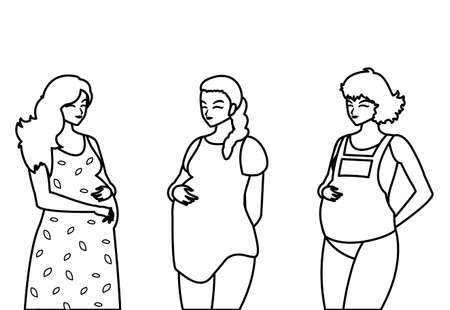Signs Your Baby Is Ready for Potty Training
Every child develops at their own pace, so its important to look for signs that your little one is physically, cognitively, and behaviorally ready before starting potty training. Rushing the process too soon can lead to frustration for both you and your child. Here are some key indicators that your baby may be ready to begin this big transition.
Physical Readiness
Your child’s body needs to be mature enough to manage bladder and bowel control. Some physical signs include:
- Staying dry for longer periods (at least two hours at a time)
- Waking up from naps with a dry diaper
- Having regular bowel movements at predictable times
- Showing discomfort when their diaper is wet or soiled
- Demonstrating the ability to pull pants up and down
Cognitive Readiness
A child’s cognitive development plays a big role in successful potty training. Look for these signs that indicate they understand the process:
- Recognizing the feeling of needing to go
- Able to follow simple instructions (e.g., “Sit on the potty”)
- Communicating when they need a diaper change or when they’ve gone potty
- Showing curiosity about how family members use the toilet
Behavioral Readiness
Your childs behavior will also provide clues about their readiness for potty training. Key behavioral signs include:
| Behavioral Sign | Description |
|---|---|
| Interest in Using the Potty | Your child watches others use the toilet and wants to imitate them. |
| Avoiding Dirty Diapers | Your baby dislikes being in a wet or dirty diaper and may try to remove it. |
| Telling You They Need to Go | Your toddler communicates either verbally or through gestures when they need to use the bathroom. |
| Able to Sit Still for a Few Minutes | Your child can sit on the potty long enough to try using it. |
| Eager to Be More Independent | Your little one enjoys taking on new responsibilities and learning new skills. |
The Right Timing Matters
If your child shows multiple signs of readiness, it may be time to introduce potty training. However, if they resist or become frustrated, it’s okay to pause and try again later. Waiting until your child is truly ready will make the process smoother and more successful in the long run.
2. Choosing the Right Potty Training Method
Every child is unique, and there are different potty training approaches to suit your little ones personality and readiness. Some methods focus on a fast transition, while others allow for gradual learning. Here are three popular potty training methods to consider:
The Three-Day Method
This method is a fast-track approach that requires dedicated time and consistency. Parents spend three days focusing entirely on potty training, keeping their child in underwear or bare-bottomed while encouraging frequent trips to the potty.
How It Works:
- Let your child go diaper-free at home for three days.
- Encourage them to use the potty frequently, especially after meals and drinks.
- Praise successes and stay patient through accidents.
Child-Led Training
This approach follows your childs pace, allowing them to show readiness signs before starting potty training. Its less structured but can reduce stress for both parents and toddlers.
How It Works:
- Introduce the potty early and let your child get comfortable with it.
- Watch for signs of readiness, like staying dry longer or showing interest in using the toilet.
- Praise every small step toward success without pressure.
Scheduled Potty Breaks
This method involves setting regular times throughout the day for potty breaks, helping create a routine that reinforces bathroom habits.
How It Works:
- Create a schedule with potty breaks every 1-2 hours.
- Encourage sitting on the potty even if they don’t need to go.
- Praise progress and gradually increase independence.
Comparison of Potty Training Methods
| Method | Main Approach | Best For | Pace |
|---|---|---|---|
| The Three-Day Method | Quick and intensive training over three days | Toddlers ready for fast learning | Fast-paced |
| Child-Led Training | Toddler decides when they are ready | Sensitive or independent children | Smooth and gradual |
| Scheduled Potty Breaks | Potties at set times throughout the day | Kiddos who thrive on routine | Moderate pace |
No single method works for all children, so its important to choose an approach that aligns with your toddlers personality and your familys lifestyle. Staying patient, consistent, and positive will help make this transition smoother!

3. Creating a Positive and Encouraging Environment
Potty training can be a big transition for your little one, and setting up a positive environment will help them feel confident and motivated. Using positive reinforcement, patience, and consistency will make the process smoother and more enjoyable for both you and your child.
Use Positive Reinforcement
Praise and encouragement go a long way in making potty training a success. Every small step your child takes, from sitting on the potty to actually using it, deserves recognition. Here are some effective ways to reinforce good potty habits:
| Method | Description |
|---|---|
| Verbal Praise | A simple “Great job!” or “You did it!” can boost confidence. |
| Stickers & Charts | Create a potty chart where your child can place stickers every time they successfully use the potty. |
| Treats & Rewards | A small reward like a favorite snack or extra story time can be motivating. |
| Dancing & Clapping | A little celebration dance or clapping session makes potty time fun. |
Be Patient and Understanding
Your toddler is learning something entirely new, so accidents are bound to happen. Instead of showing frustration, reassure them that its okay and encourage them to try again next time. Avoid negative reactions like scolding, as this could create fear or anxiety around potty training.
Create a Routine and Stay Consistent
A structured routine helps children understand when to use the potty. Try these tips to maintain consistency:
- Set Regular Potty Breaks: Encourage your child to sit on the potty at regular intervals, such as after meals or before bedtime.
- Dress for Success: Use clothes that are easy to pull down quickly so they can reach the potty in time.
- Keep the Potty Accessible: Place the potty chair in a convenient spot where your child spends most of their time.
- Avoid Diaper Confusion: Once you start potty training, try using training underwear instead of switching back to diapers frequently.
Create a Fun and Engaging Experience
The more comfortable and engaged your child feels, the easier the transition will be. You can:
- Add Books & Songs: Read potty-themed books or sing songs while they sit on the potty to make it an enjoyable experience.
- Name the Potty Chair: Giving their potty chair a fun name can make them more excited about using it.
- Pretend Play: Let your child “teach” their stuffed animals how to use the potty—it reinforces their learning!
A positive and encouraging environment sets the foundation for successful potty training. By celebrating small wins, being patient with setbacks, and staying consistent with routines, you’ll help your little one build confidence in this new milestone.
4. Handling Accidents and Setbacks
Potty training is a big milestone, and accidents are a normal part of the process. It’s important to stay patient and supportive as your child learns. Reacting with frustration or disappointment can make them feel ashamed, which may slow down their progress. Instead, focus on encouragement and problem-solving.
Stay Calm and Reassuring
When an accident happens, take a deep breath and remind yourself that this is part of learning. Instead of scolding, use positive reinforcement:
- Say something reassuring like, “That’s okay! Next time, we’ll try to get to the potty sooner.”
- Encourage your child to help clean up in a gentle way, so they understand responsibility without feeling punished.
- Praise their effort rather than focusing on the mistake.
Recognizing Common Triggers
Accidents often happen for specific reasons. Identifying patterns can help prevent future mishaps.
| Common Cause | How to Handle It |
|---|---|
| Your child is too busy playing | Remind them to take potty breaks regularly. |
| Your child is afraid of using the potty | Offer encouragement and make it a comfortable experience. |
| Your child doesnt recognize the urge yet | Watch for signs and gently guide them to the bathroom. |
| A change in routine (travel, new environment) | Stick to a schedule as much as possible and be patient with adjustments. |
Avoiding Stress and Shame
Your reaction plays a huge role in shaping your child’s confidence. Keep these tips in mind:
- Avoid using negative words like “bad” or “naughty.” Instead, focus on solutions.
- If they seem frustrated, reassure them that learning takes time.
- If accidents continue frequently, consider if they might not be ready yet and take a short break before trying again.
Praising Progress
Acknowledge small wins! Even if they don’t make it to the potty every time, celebrate when they recognize the urge or try on their own. A little encouragement goes a long way in building their confidence.
5. Transitioning from Diapers to Underwear
Moving from diapers to underwear is a big step in potty training. It signals to your child that they are growing up and encourages them to use the potty consistently. This transition should be handled with patience and positivity to make it as smooth as possible.
Introducing Underwear
Choosing the right time to introduce underwear can make a big difference. Once your child has had some success using the potty and can stay dry for longer periods, they may be ready to switch from diapers to underwear. Letting them choose their own underwear with fun colors or favorite characters can also make the process exciting.
Steps to Introduce Underwear:
- Let Your Child Pick: Take them shopping and let them choose underwear they like.
- Explain the Change: Tell them that wearing underwear means they need to use the potty instead of diapers.
- Start at Home: Begin by having your child wear underwear during the day when youre at home, so accidents can be managed easily.
- Praise Success: Celebrate when they successfully use the potty while wearing underwear.
- Be Patient with Accidents: Expect some accidents and reassure your child that its okay while encouraging them to try again.
Handling Nighttime Training
Naptime and nighttime dryness often take longer than daytime potty training. Some children may still need diapers or pull-ups at night even after transitioning to underwear during the day. Here are some ways to support nighttime training:
| Strategy | Description |
|---|---|
| Limit Fluids Before Bed | Avoid giving too many drinks close to bedtime to reduce nighttime accidents. |
| Create a Bedtime Routine | Encourage your child to use the potty before going to bed every night. |
| Use Waterproof Bedding | A mattress protector can help manage any nighttime accidents. |
| Praise Dry Nights | If your child wakes up dry, celebrate their progress without pressure. |
| Be Patient | If accidents happen, stay calm and reassure them that their body is still learning. |
Making the Transition Smooth
The key to a smooth transition is consistency and encouragement. Keep extra clothes handy for quick changes, remind your child regularly about using the potty, and avoid punishment for accidents. The goal is to build confidence and independence in your little one as they learn this new skill.


